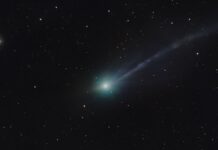NASA will unveil fresh imagery of the interstellar comet 3I/ATLAS on Wednesday, November 19, during a live-streamed press conference at 3 p.m. EST (2000 GMT). The event will showcase observations collected from multiple NASA missions, offering unprecedented insights into this rare celestial visitor.
A Rare Interstellar Visitor
Comet 3I/ATLAS was first detected on July 1, 2023, by the ATLAS (Asteroid Terrestrial-impact Last Alert System) observatory, a NASA-funded project designed to identify potentially hazardous near-Earth objects. What sets this comet apart is its interstellar origin — meaning it did not form within our solar system but originated from another star system. This marks only the third time scientists have confirmed an interstellar comet passing through our neighborhood, following the discoveries of 1I/’Oumuamua in 2017 and 2I/Borisov in 2019.
Closest Approach and Increased Activity
On October 29, 3I/ATLAS reached its closest point to the Sun, a key milestone known as perihelion. At approximately 130 million miles (210 million kilometers) from our star, the comet experienced increased solar heating, potentially triggering heightened cometary activity, such as outgassing and tail formation. While NASA’s initial announcement does not explicitly preview these details, the new images are expected to reveal such changes.
Multi-Mission Observations
NASA officials emphasize that the agency’s ability to observe 3I/ATLAS throughout its passage through the solar system is unique. The comet is being studied by a combination of spacecraft across the solar system and ground-based observatories. This multi-faceted approach allows scientists to gather complementary data from various perspectives, using different scientific instruments to understand the comet’s behavior in detail.
Briefing Participants
The press conference will feature key NASA representatives:
- Amit Kshatriya, NASA Associate Administrator
- Nicky Fox, associate administrator, NASA’s Science Mission Directorate
- Shawn Domagal-Goldman, acting director, NASA’s Astrophysics Division
- Tom Statler, NASA lead scientist for solar system small bodies
The briefing is expected to provide a comprehensive overview of the latest findings and images, shedding light on the comet’s composition, trajectory, and interaction with the solar environment.
The study of interstellar comets like 3I/ATLAS is crucial for understanding the formation and evolution of planetary systems beyond our own. These objects carry clues about the conditions in their parent star systems, offering a glimpse into the diversity of planetary environments across the galaxy.
The live stream of the press conference will be available on Space.com and directly through NASA’s official channels



























